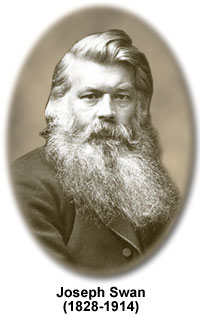Joseph Swan
(1828-1914)

Joseph Swan was a chemist, physicist, and inventor, who is most famous for his important role in the development of electric lighting. He was born in Sunderland, England on October 31, 1828 to John and Isabella Swan. A particularly inquisitive child interested in creative endeavors, he began an apprenticeship with a pharmacist when he was 13. Afterwards, he began as an assistant in a firm of manufacturing chemists, in which he worked his way up, eventually becoming a partner.
The chemical company that employed Swan, among other goods and services, produced photographic plates, which led Swan to some of his most impressive scientific innovations. In 1862, he patented the first commercially feasible procedure for carbon printing in photography. Then, having observed that heat increases the sensitivity of silver bromide emulsions, Swan invented the dry plate in 1871, followed by the development of bromide photographic paper in 1879.
Beginning in the 1840s Swan undertook his most important studies. It was at this time that he began his experiments with incandescence for illumination purposes. It was not until 1860, however, that Swan received a patent for a carbon filament incandescent lamp, which operated in a partial vacuum. The most significant feature of Swan's lamp was that it lacked enough residual oxygen in the vacuum tube to ignite the filament, thus allowing the filament to glow almost white-hot without catching fire. Swan's first electric lamps did not provide a significant amount of illumination and required a battery source to be located close to the light source. These limitations compromised the practicality of his invention until 1879 when Swan was able to demonstrate an advanced light bulb in Britain.
While searching for a better filament for his light bulb, Swan inadvertently made another advance. He developed and patented a process for squeezing nitro-cellulose through holes to form fibers. His newly established Swan Electric Company, which by merger was to become the Edison and Swan United Company, used the cellulose filaments in their bulbs. However, the textile industry also used Swan's method to create artificial fibers for clothing and domestic products.
Swan was elected to the Royal Society in 1894 and was president of the Institution of Electrical Engineers from 1898 to 1899. He also served as president of the Society of Chemical Industry in 1901, the same year he was awarded an honorary doctorate degree from Durham University. Knighted in 1904, Swan died ten years later on May 27, 1914 in Surrey, England.
